By Dave McCracken General Manager

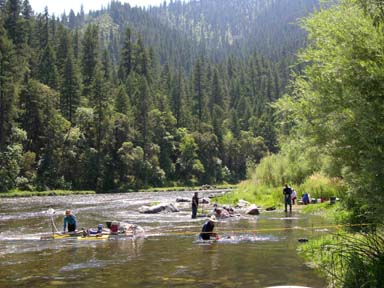
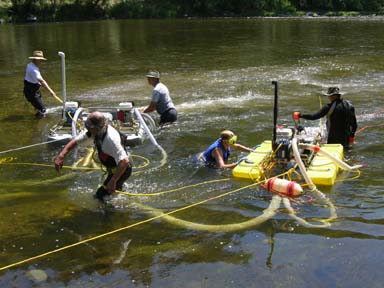
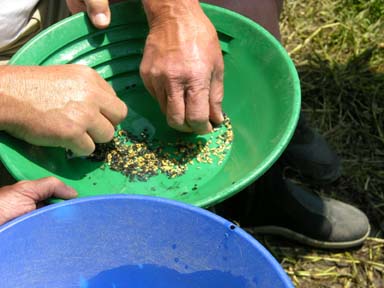
It’s always a great feeling for me to watch one high-grade gold discovery evolve into another exciting discovery through just a little more sampling further upstream. This substantiates our long-established theory that most high-grade gold deposits follow a common path down along the bottom of a gold-bearing waterway. More often than not, further sampling along the same path upstream or downstream from an already established high-grade pay-streak in the river will turn up additional rewarding gold deposits, sometimes even richer than the first!
And that’s what happened in this case. The first high-grade pay-streak that we located was directly at the top-end of the (very) extensive gravel bar near the top-end of K-15A (Mega-hole claim). You can read about how we made that fantastic discovery during a surface mining (high-banking) project in our July newsletter.
The thing that made this event so interesting is that it was the first time that we ever tracked the Klamath River’s gold path from a high-grade deposit up on a gravel bar to high-grade gold out in the active river; very exciting indeed! No doubt, this will have us taking a fresh look at other sections of the river this next season!
It was early during this past season, and Haze and Andi Williams had already consented to capture the video and photography for all of the week-long mining projects for the summer. They were also looking for a good place to put their new 5-inch dredge while they were in the process of filming the surface mining project in late June. So when Craig Colt made the high-grade gold discovery at the top-end of the gravel bar on K-15A, we all did the natural thing; we looked just upstream in anticipation of what might be a continuation of the pay-streak. Haze and Andi moved their dredge into location just upstream only a few hours after Craig made that discovery. This turned out to be a really smart move! Not surprisingly, they found the very same type of gold (course and nuggety) in the very same type of streambed material (ancient, compacted, dark-colored) at about the same depth below the surface.
It only took a few dredge samples before Haze and Andi were in high-grade gold just upstream from the gravel bar where Craig had made the original discovery. They were into it pretty good just before we started this dredging project. The nice thing about this deposit was that it was located in shallow, slow-moving water, not far from the edge of the river. This was a very safe place for beginners to dredge. Since they were going to be involved with this dredging project anyway, Haze and Andi suggested that we start the project in the gold deposit they had just located. This sounded good to me. It’s always good to begin a week-long project in a place where we can start some of the dredges working in an established gold deposit!
There were 24 of us involved with this dredging project, including myself. The first thing we did was gain permission from a landowner living across the road from Highway 96 (a New 49’er member) who possesses an access road which would allow our group to gain an easy perch at the top-end of K-15A, near to where Andi and Haze had been dredging their gold. An access road was going to save our crew from making a pretty fair hike in and out of the site every day. That was good!
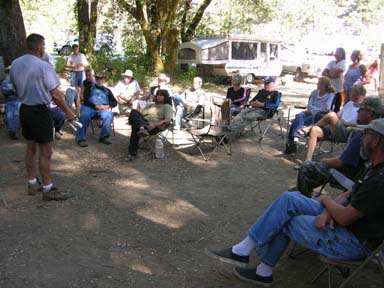 The first thing we do is set up a camping area where we can have our planning sessions each morning.
The first thing we do is set up a camping area where we can have our planning sessions each morning.
The first day on these projects is usually focused upon setting up a group camping area and launching all of our dredging gear into the river and setting it up. There is a wonderful, shaded camping area on K-15A. Once we were all set up there, all I had to do was make a comment that the access road needed a little work before we could launch our dredges. By the time I got over there, the work had already been completed and we had easy access to the river, along with a nice place to stage the beginning of our program. It was great! This crew was so geared up to go, I quickly realized that it was time to assign some team leaders and let them get to work!
Andi and Haze offered us the use of their dredge, so we added an additional airline to allow a second person underwater. This team was so motivated, that we had a team already working in gold before lunch on the first day! As Haze and Andi were tied up capturing video and photography, others completely took their dredge over for the whole week and they didn’t seem to mind. They were showing off nice gold on that dredge just within the first few hours. That got the whole team pretty excited!
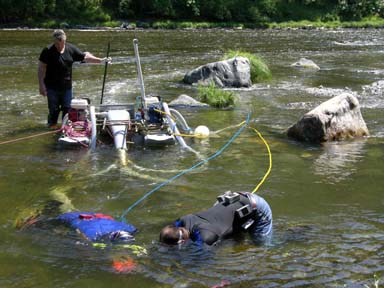
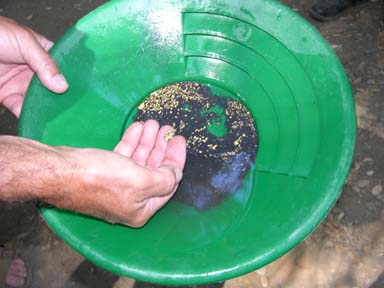
The team got right to work on Haze & Andi’s dredge!
The rest of our team stayed busy on the first afternoon launching a 4-inch dredge, two 5-inch dredges and a 6-inch dredge. Craig Colt had just finished devoting 3+ months into building the best 8-inch dredge ever made for the Klamath River. But we wanted to establish a good gold deposit where we could use it, before launching that beast into the river!
We placed the 4-inch dredge in shallow water just off the little perch that we had made, a perfect place where we could show beginners how to do the underwater work. This location was about 150 feet directly upstream from where Andi and Haze had been dredging some very nice gold, so the prospects were pretty good that our beginners would also find something good on the bottom.
During the first several days on these projects, we are more concerned with just helping beginners to overcome the underwater environment in a location where the water is slow and shallow enough so that there is very little danger of having any accidental traumatic encounters. It’s not uncommon for some participants to arrive who have some fear of the water, perhaps from an earlier near-drowning event. We have found that the key in helping someone to overcome these fears (if they want to try), is through a progression of easy steps, starting with something which nearly anyone can do.
The following video sequence captures how we follow a step-by-step process to help beginners become a productive part of the underwater mining crew:
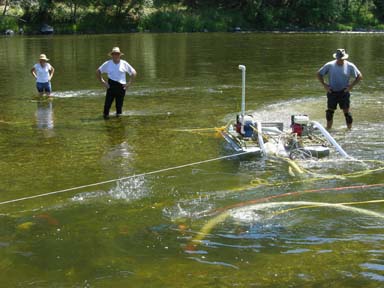 This was a very easy location where beginners could learn!
This was a very easy location where beginners could learn!
The place where we set up the 4-inch dredge on this project was about the easiest I have ever seen. There was a shallow, even bottom in clear water where beginners were able to get used to crawling around along the bottom of the river in a safe place. It wasn’t long before all of our beginners were down helping in the dredge hole!
By the end of our second day, all of our beginners had eagerly progressed through their early steps and were contributing to forward progress in the water.
All of our beginners were initially assigned to the 4-inch dredge on this project. The rest of the crew was teamed up on the other dredges. One dredge was used to put down a sample hole about half way between the 4-inch dredge and Haze’s dredge. With good luck going our way, that dredge touched right down on beautiful gold within the first few hours.
Another dredge was sent several hundred feet upstream from the 4-inch dredge to do another test hole. But it could not find any hard-pack streambed up there. After several
tries, we decided that the river dynamics in that area did notallow hard-pack to form during previous major flood storms. Ultimately, that dredge was drifted down to work side-by-side with another dredge in the pay-streak.
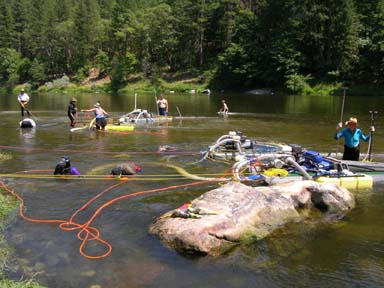 The 6-inch dredge was drifted across the river to dredge some samples on the other side. This, because some members had reported several years ago that they were finding nice gold over there mixed with pieces of metal from some kind of old Chinese camp. This all took place at the top end of K-15A. But we were not able to find hard-pack streambed on the far side of the river, and did not want to invest very much time over there since we were doing so well on the road-side. One hard effort was made to dredge a sample in the middle of the river, but we gave up when the loose streambed material reached around 6 feet deep.
The 6-inch dredge was drifted across the river to dredge some samples on the other side. This, because some members had reported several years ago that they were finding nice gold over there mixed with pieces of metal from some kind of old Chinese camp. This all took place at the top end of K-15A. But we were not able to find hard-pack streambed on the far side of the river, and did not want to invest very much time over there since we were doing so well on the road-side. One hard effort was made to dredge a sample in the middle of the river, but we gave up when the loose streambed material reached around 6 feet deep.
Meanwhile, our hard-charging beginner-team on the 4-inch dredge had managed to establish a pretty high-grade portion of the pay-streak in about 4 feet of hard-pack streambed, just behind a major change in bedrock. This turned out to be the reason for the pay-streak in the first place. There was a 4-foot bedrock drop-off; behind which, was filled with a hard-packed assortment of boulders and ancient hard-packed material. Here, beautiful golden nuggets were found along the bedrock. Once again, the beginner-team had walked right into the richest part of the pay-streak! With lots of excitement, the guys and gals on that crew worked out a continuous round of shifts, only shutting down the dredge long enough to put more fuel in the tank.
Here follows a video segment of a 4-inch clean-up that Haze captured during one of the first few days. It’s not surprising that the beginners learned how to dredge so quickly!
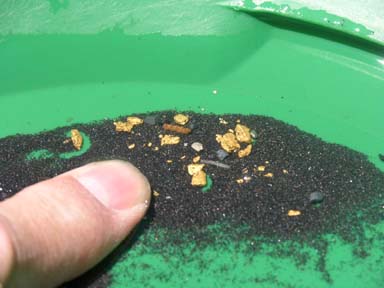
The beginner-dredge was bringing up nuggets on nearly every dive!
There was plenty of hooping and hollering going on about the beautiful nuggets being found on the 4-inch dredge. The nicest gold from the week was found by people who had never even operated a dredge before!
When some of the boulders were too large to move by hand, as a team effort, we moved in winching gear and attempted to pull them out of the way. Several of the huge rocks proved to be even too large for our winch, so they still remain in place, probably sitting on top of the best gold nuggets!
By mid-week, we had strategically positioned five dredges on top of the pay-streak and evolved ourselves into production operation. Here follows a video sequence of the productive activity once our team really got dialed in:
A sixth dredge was floated further down K-15A to sample for more high-grade gold deposits. My trusty helper, Craig Colt and I supervised this sampling, because most of it was done in either deep or very fast water.
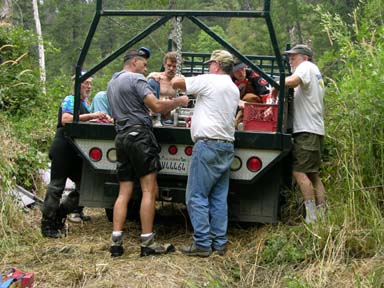
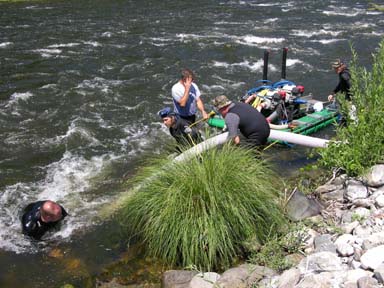
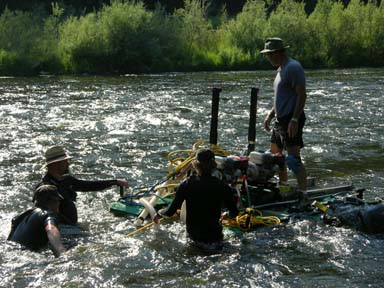
All in all, we completed 5 good sample holes in several hundred yards of river. Each of the holes were put down to bedrock in ancient, original Klamath River streambed (never been mined before).
Because Andi and Haze had donated a pay-streak to this project that was easy to work in a location where there was near-zero risk that anybody could be hurt (slow, shallow water), we were in a unique position where Craig and I could run off with the most experienced participants and do some serious sampling. So we took the opportunity to place several sample holes down in a part of upper K-15A that we didn’t (until then) know anything about. The risk in this type of sampling is that we might not find much gold. Since we already had 5 dredges producing in gold, our group unanimously agreed that the risk was worthwhile just to see what we might find in that virgin section of the river.
Dredging sample holes in deep or fast water areas that you know nothing about is a very challenging activity; definitely not for the light-hearted! The main challenge is that you usually don’t know how deep the streambed is going to go before you reach bedrock. This leaves you with all kinds of uncertainties along the bottom of the river. The best thing to do is just pour on the steam the best you can. And it’s always a great feeling when you do reach the bottom! The whole program feeds on a never-ending stream of hope. Here follows a video segment captured as our sampling program was happening out on the water:
We were severely challenged by one section of very fast water which we believed, because of the difficulty, nobody had ever sampled before. The following video sequence captured some of the team spirit and fun involved in our sampling effort. Keep in mind that this is all the real thing. There is no play acting here. There is just a video camera that happens to be present while we were doing the work:
There was gold in each of the holes, but not the high-grade we are looking for. That’s just that way it goes in sampling; every stretch of river does not give up high-grade on our first pass through the area. Still, we did establish to our own satisfaction that most of this portion of the Klamath River remains void of any previous mining activity. This is a very good thing! The gold is there. It will just take some time to find it!!
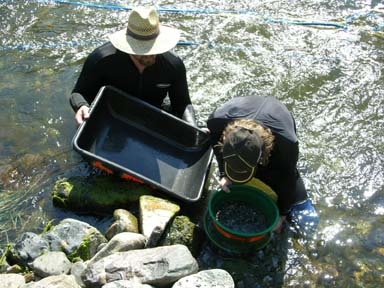
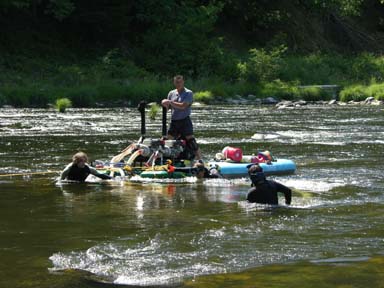
Since K-15A is so close to Happy Camp, I was going home every night. Andi and Haze were also returning to Happy Camp. So they were able to capture amazing video footage of a forest fire that had just started up from a massive thunder storm during the dredging project. The fire was so severe, for several days, there was talk of evacuating the whole town!
We were fortunate to have Otto Gaither back this season as our shore boss. Otto adds a wonderful human touch to these projects. While Craig and I are more focused on the production-side of things, Otto is more concerned with making sure that people are eating right. Otto also started managing the beginner-dredge on this project, and the beginner-dredge has been breaking production records ever since. Everybody was raving about the meals at Otto’s camp during the mornings and evenings.
There is always a magic cultural chemistry which comes together in these projects, each one distinctly different from the rest – always with Otto at the center. And this project was no different. Towards the last day, when we realized that, as hard as our advanced team had worked in our extreme sampling efforts to locate some exciting, new high-grade, it was going to be the hard work of our main crew under Otto’s leadership, in a gold deposit that had been freely contributed by Haze and Andi, that was going to carry our week. And everybody was alright with that.
We pulled all of our gear off the river on the final day and performed a full clean-up of the week’s gold production. Everyone participates in every step of this process. Several other participants moved their personal dredges into the pay-streak to continue working it. Andi and Haze continued to work the same pay-streak throughout the remainder of the season, and did good until the cold weather chased them out. That was a great deposit!
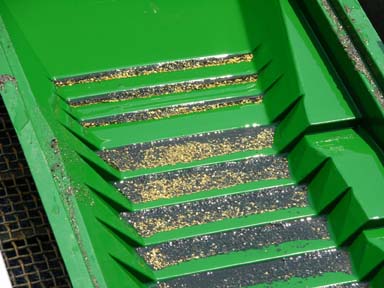
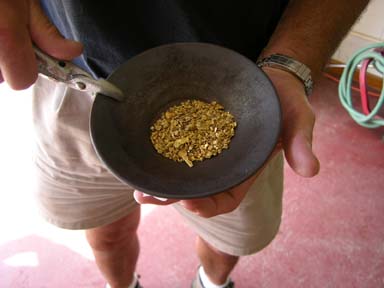
All in all, we recovered 95.5 pennyweights of beautiful gold on this project, of which 56.3 pennyweights (more than half) consisted of nuggets. This allowed for just under a ¼-ounce share for each participant in the project.
- Here is where you can buy a sample of natural gold.
- Here is where you can buy Gold Prospecting Equipment & Supplies.
- Other Group Mining Adventures
- Project schedule
- More about how to prospect for gold
- Books & Videos by Dave McCracken





